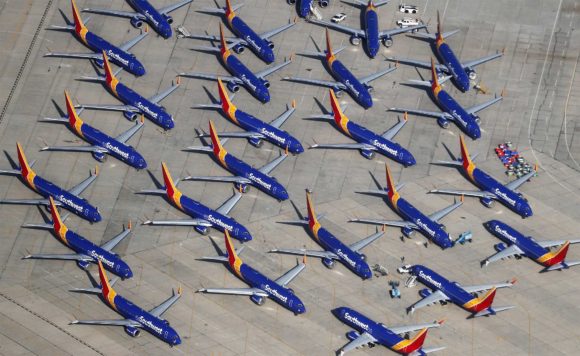U.S. aviation regulators will conduct the final approval of factory-fresh Boeing Co. 737 Max jets rather than allowing company employees to handle routine sign-offs before the planes are delivered.
The plan amounts to the latest signal from the Federal Aviation Administration that it intends to retain full control over all aspects of the grounded jetliner as Boeing prepares to finalize fixes and restart shipments to customers. The Max, the company’s best-selling model, has been banned from flying since March after two deadly crashes killed 346 people.
FAA Administrator Steve Dickson has been emphasizing that the agency won’t be pushed to move too hastily on decisions related to the Max, even as tensions rise between the planemaker and its chief regulator. That may add to the difficult logistics that Boeing faces once the Max is cleared to fly, as it works with airlines and lessors to return the jetliner to passenger service.
“The FAA notified Boeing today that the agency will retain authority over the issuance of Airworthiness Certificates for all newly manufactured 737 Max aircraft,” the agency said in a statement Tuesday.
Boeing fell 1.4% to $368.20 at 9:48 a.m. in New York, the biggest decline on the Dow Jones Industrial Average. Since the second Max crash, the shares fell 12% this year through Tuesday, while the Dow advanced 11%.
Separately, the Seattle Times reported Wednesday that the damage from a September stress test on a different model, the 777X, was worse than previously disclosed. An explosive depressurization ripped the fuselage skin wide open, the newspaper said.
Delivery Goals
Regarding the 737 Max, Boeing said earlier this month that it might be able to begin delivering the first of hundreds of idled planes before the end of the year. The FAA hasn’t said whether it would allow that to happen before new pilot training standards are adopted early next year.
“We continue to follow the lead of the FAA on the safe return to service of the Max,” said Chaz Bickers, a spokesman for Chicago-based Boeing.
At the current production pace, Boeing could have 386 newly built Max in storage by the close of 2019, Cowen analyst Cai von Rumohr said in a report last month.
The manufacturer has stashed freshly minted Max around the Pacific Northwest and as far afield as San Antonio since the plane was grounded March 13. Boeing isn’t allowed to deliver the single-aisle aircraft while the flying ban is in place.
The large number of planes awaiting delivery significantly exceeds any previous backlog and such a circumstance wasn’t considered when FAA granted Boeing employees authority to make approvals of aircraft, the agency said in a letter sent Tuesday to the company.
As a result, “the FAA has determined that the public interest and safety in air commerce require that the FAA retain authority to issue airworthiness certificates and export certificates of airworthiness for all 737 MAX airplanes,” the agency said in the letter.
The FAA will perform the sign-offs until Boeing can show its quality control processes are adequate to handle the unusual situation, the agency said.
Teams of Boeing mechanics and engineers have been working to prepare the first aircraft to be handed over to customers as the Max is recertified in the U.S. and then cleared by other regulators. Each plane is outfitted with bespoke equipment and cabins selected by airlines, and must clear flight tests before airlines and lessors take ownership.
Potential Delays
While the FAA latest action might make it more difficult for large numbers of planes to be delivered by year-end, the extent of the delays — if any — isn’t clear. The agency has enough employees to keep up with the inspections that are done on planes as they come off the assembly line, said an official familiar with the agency’s action.
Nevertheless, Boeing’s Nov. 11 statement that it hoped to resume deliveries of the plane before the end of 2019, which caused the company’s shares to jump, rankled FAA officials, according to the official and another person familiar with the situation.
Boeing Chief Executive Officer Dennis Muilenburg requested that the handovers begin in a phone conversation with Dickson, according to the people, who weren’t authorized to speak on the matter and asked not to be named. The FAA chief later reiterated in a statement and video message to employees that agency staff wouldn’t be pressured into hurrying their work.
Several steps remain before the plane can return to the skies in the U.S. The agency must approve Boeing’s software fixes to the plane and test them with groups of foreign pilots. FAA’s own test pilots must also fly the plane.
Pilot Training
Additionally, the agency is drawing up a new training course for pilots before they can fly the plane. That isn’t expected to be completed until January. No decision has been made at FAA on whether Boeing can deliver planes to customers before the training is completed.
Regulators outside the U.S. must also sign off on the redesign and the training separately.
The issue of how much authority the FAA has granted Boeing to use its own employees to sign off on designs and other work has been controversial since the crashes. The flight-control feature on the plane linked to the crashes was partially approved by Boeing’s engineers.
The FAA statement Tuesday referred to more routine approvals the agency makes on individual aircraft built in the U.S. to ensure they were built as designed.
–With assistance from Christopher Jasper.
Was this article valuable?
Here are more articles you may enjoy.


 Insurance Industry Contemplates Knock-On Effect of Tariffs to Claims, Consumers
Insurance Industry Contemplates Knock-On Effect of Tariffs to Claims, Consumers  As Trump Considers Auto Tariffs Pause, Parts Exemptions Could Be Key for US Industry
As Trump Considers Auto Tariffs Pause, Parts Exemptions Could Be Key for US Industry  Tariff Panic Spurs Fastest Retail Sales Growth in Two Years
Tariff Panic Spurs Fastest Retail Sales Growth in Two Years  UAW Joins Critics Slamming RFK Jr.’s Cuts to Worker Safety Unit
UAW Joins Critics Slamming RFK Jr.’s Cuts to Worker Safety Unit 